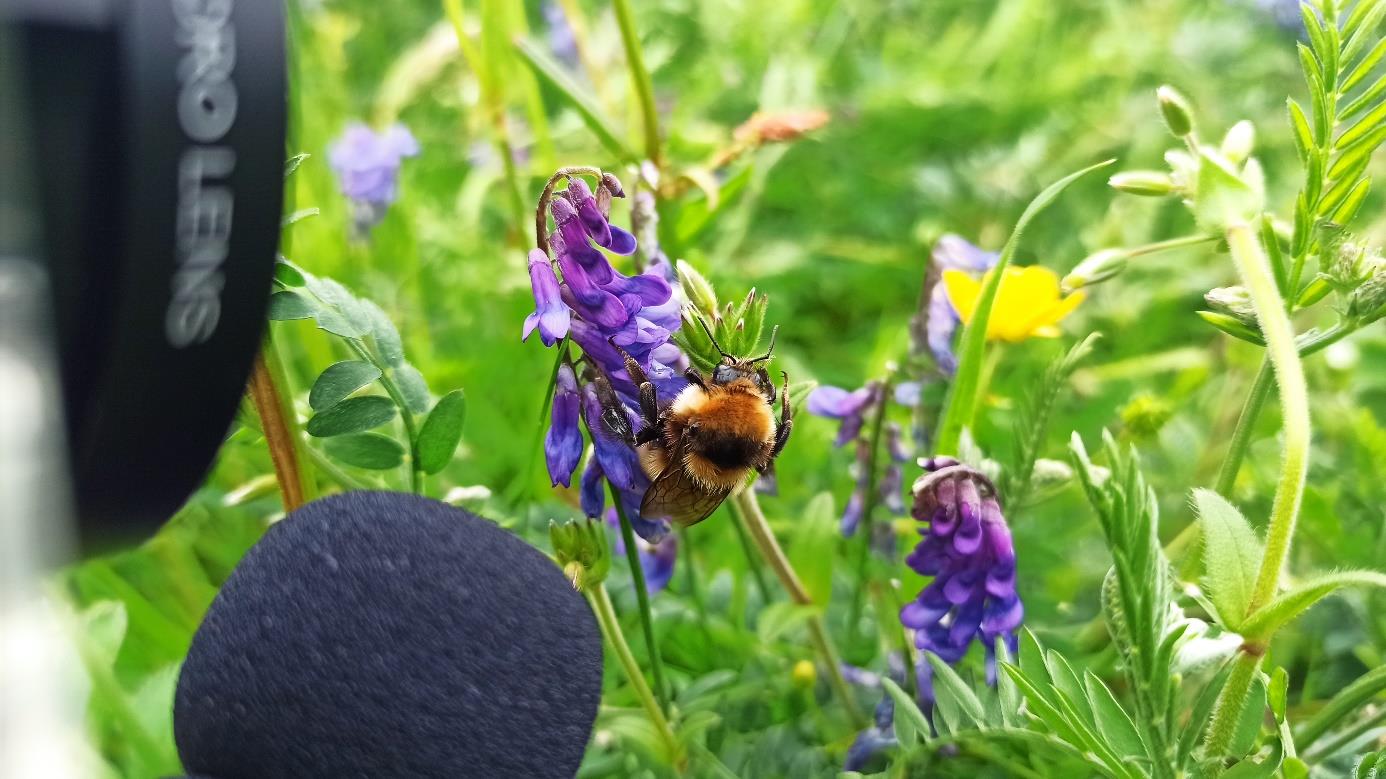Why the project was necessary
While the importance of insect pollinators in the maintenance of wild, ornamental and crop plant communities is widely acknowledged, there is clear evidence of a global pollinator decline. In particular, recent findings in Europe highlight a striking decline in bumblebee populations since the beginning of the 20th century1. However, the extent of the decline remains to be assessed for many species, both in terms of distribution and population trends. The urgency of tracking the responses of these cold-adapted pollinators to ongoing climate change and habitat modification cannot be overstated. It is imperative that standardized, wide-scale monitoring is undertaken promptly to facilitate the formulation and implementation of targeted conservation strategies.
Even in countries with long-established biodiversity monitoring programmes, such as the United Kingdom (UK), there is a lack of standardised, long-term data for bumblebees and other wild insect pollinators at large spatial scales2. While citizen science projects (e.g. BeeWalk scheme in the UK) could partly fill this gap, remote areas and elusive/rare species (despite being the most threatened) are often overlooked or difficult to monitor in such schemes. Indeed, traditional methods for monitoring bumblebees (e.g. visual counting, sweep netting) and associated ecosystem services such as pollination are laborious and resource-intensive, limiting our ability to monitor over large spatial scales and long time periods. There is also the paradox that some of the other methods commonly used to study bumblebees, such as the use of pan traps, are lethal, presenting a challenging ethical dilemma in bumblebee conservation and monitoring practices. The present situation highlights the urgent need for innovative, non-invasive monitoring techniques that can provide greater spatial coverage and long-term insights. Filling this critical gap is essential to advancing effective bumblebee conservation strategies.
Thanks to recent technological and methodological advancements, the use of acoustic sensors offers exciting developments for future monitoring programmes of bumblebees3. Indeed, the characteristics of buzzing sounds of bumblebees are very likely to be both species- and behaviour- specific (e.g. flying vs. pollinating)4-7. While buzzing sounds are highly complex, recent developments in artificial intelligence (AI; e.g. deep learning, transfer learning and data augmentation)8 hold significant promise for classifying bumblebee species and behaviour, but have not yet been fully explored with the most up-to-date artificial intelligence innovations.
Aims and objectives
The primary aim of this work is to create and develop a bioacoustic toolbox for surveying European bumblebee species and behaviour in a cost-effective and non-invasive way. This project builds on emergent technologies that are currently revolutionising insect ecology and monitoring (here bioacoustics and recent machine learning innovations). The objectives are twofold: (i) create an open-access reference library of buzzing sounds from bumblebee species, and (ii) develop, train and test Artificial Intelligence algorithms for automatically recognizing bumblebee species and behaviour from their buzzes.
Methodology
The project consisted of three phases: fieldwork, desk-based acoustic analysis, and development of artificial intelligence (AI) algorithms. Fieldwork consisted of recording bumblebee buzzes in their natural habitat using synchronised acoustic recorders and cameras (Figure 1) to reliably attribute each individual buzz to a behaviour and a species (whenever possible). In addition, bumblebees were captured and then released in a flight tent to collect more information (such a wing condition and body weight of the individual caught) alongside their buzzes (Figure 2).
Fieldwork took place throughout Scotland, Southern Wales and in the French Alps. We used open- source acoustic software to annotate each sound recorded in the field and started building a massive reference library of species- and behaviour-specific buzzing sounds (see a sample in Figure 3). Finally, we developed, trained, and tested AI algorithms and assessed their potential in terms of reliability and accuracy for automatically recognizing bumblebee species and behaviour from their buzzes. More specifically, we used a pre-trained deep neural network (PANNs, trained on Audioset) and fine-tuned it on the training set.

Figure 1- Recording of a great yellow bumblebee (Bombus distinguendus)
foraging over a machair on a tufted vetch (Vicia cracca) in South Uist (Scotland).

Figure 2- Experimental stet-up to record bumblebees flying in a flight tent
after capture (Glorious Gardens of Argyll & Bute, Scotland).

Figure 3- Spectrogram of a worker bilberry bumblebee (Bombus monticola)
flying between flowers in the Cairngorms National Park, Scotland.
Outcomes
Library of buzzing sounds - Since March 2023, we have recorded and annotated >5000 sound events from 18 social bumblebee species and two cuckoo bumblebees. For each sound event, we have information on the species (or species complex), cast, buzz type (flight vs. pollination buzz), timestamp, location, and visited flower. For half, we further have information on wing condition and body weight, crucial for contextualizing the recordings. We are now working on a data paper to make this library of recordings available to everyone interested in bumblebee sounds.
AI algorithms - Initial algorithm trials on a subset of the data have demonstrated promising outcomes, with high accuracy and reliability scores (>0.8 on a scale between 0-1) for the most common species. Nevertheless, worker size polymorphisms add extra challenges in species identification and require collecting and annotating more recordings for rarer bumblebee species and implement data augmentation method (for instance using SpecAugment). Detecting and disentangling pollination from flight buzzes would seem to be a relatively easy task, but more work is still needed to fine tune the algorithms.
Future directions
The buzzing sound library continues to expand, with new recordings from various related projects arising from this one added monthly. This growing resource will not only be invaluable for bumblebee-focused research but also holds potential for other biological sound classification studies. We plan to include additional buzzing species, such as hoverflies, and extend the geographic scope of recordings. Our goal is for this repository to become a versatile, collaborative asset that advances acoustic monitoring techniques and contributes to biodiversity conservation efforts globally.
We will continue to develop the AI algorithm for species/behaviour recognition to improve its accuracy and reliability before its integration within an operational acoustic toolbox. We also plan to deploy acoustic recorders in the field to test the efficacy of the bioacoustic toolbox for monitoring bumblebees over large spatio-temporal scales. Our goal will be to refine the toolbox and sampling strategy for smooth integration within monitoring and citizen science projects led by the Bumblebee Conservation Trust in the UK and the French National Museum of Natural History in France.
How you benefitted from ECT funding
The ECT funding has been instrumental in allowing me to make a strong start on this challenging project. The ‘preliminary’ work made possible by this support has enabled me to secure additional grants to continue the project, expand its scope, and build new collaborations (both with researchers and practitioners, thus bridging the gap between science and on-the-ground biodiversity conservation and monitoring). Without ECT's funding, it would not have been possible to collect such a large amount of data and label the vast range of sounds that form the basis of the library and the prerequisite for the development of the AI algorithm. I am very grateful for the funding. It has given me the opportunity to take my research in new and exciting directions.
Jérémy Froidevaux & Kirsty Park, University of Stirling, UK
Ref.: ECT_20221215
Completed 2024
References
- Ghisbain, G. et al. Projected decline in European bumblebee populations in the twenty-first century. Nature, 1-5 (2023).
- Casey, L., Rebelo, H., Rotheray, E. & Goulson, D. Evidence for habitat and climatic specializations driving the long-term distribution trends of UK and Irish bumblebees. Diversity and
Distributions 21, 864-875 (2015).
- van Klink, R. et al. Emerging technologies revolutionise insect ecology and monitoring. Trends in ecology & evolution (2022).
- Gradis ek, A. et al. Predicting species identity of bumblebees through analysis of flight buzzing sounds. Bioacoustics 26, 63-76 (2017).
- Ribeiro, A. P. et al. Machine learning approach for automatic recognition of tomato-pollinating bees based on their buzzing-sounds. PLoS computational biology 17, e1009426 (2021).
- Truong, T. H., Du Nguyen, H., Mai, T. Q. A., Nguyen, H. L. & Dang, T. N. M. A deep learning-based approach for bee sound identification. Ecological Informatics 78, 102274 (2023).
- Rodrí guez Ballesteros, A., Desjonque res, C., Hevia, V., Garcí a Llorente, M., Ulloa, J. S., & Llusia, D. Towards acoustic monitoring of bees: Wingbeat sounds are related to species and individual traits. Philosophical Transactions of the Royal Society B: Biological Sciences, 379(1904),
20230111. (2024).
- Borowiec, M. L. et al. Deep learning as a tool for ecology and evolution. Methods in Ecology and Evolution 13, 1640-1660 (2022).

